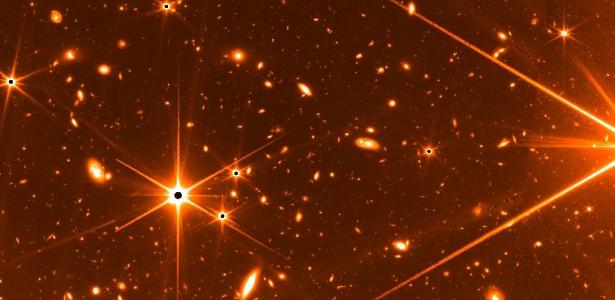NASA scientists have sampled the power of the James Webb telescope, the largest and most expensive telescope ever made. The image released by the American space agency shows a glimpse of the first images of deep space captured by the equipment. This was just an appetizer — the official images will only be released on July 12th.
Talk about an overachiever!
Gaze at this test image — an unexpected & deep view of the universe — captured by Webb’s Fine Guidance Sensor (FGS) in May. Built by @csa_asc to point Webb precisely at targets, taking glamour shots isn’t even FGS’s main job: https://t.co/aQUAFHcNV5 pic.twitter.com/uYoh4t8PX2
— NASA Webb Telescope (@NASAWebb) July 6, 2022
–
On Twitter, the agency says that “taking glamorous pictures isn’t even the main job” of the telescope – despite having spectacular results – and that the image “is among the deepest ever observed in the universe”.
The main purpose of the equipment is to allow accurate scientific measurements. When the sensor captures images, they are not normally stored given the communication bandwidth between the telescope and Earth.
Just a ‘straw’
Almost as exciting as the image is to imagine that it is just a small sample of the Fine Guidance Sensor (FGS), the telescope’s orientation sensor. At this point, the space observer just tries to ensure that the cameras and mirrors that make up the equipment are correctly aligned.
“The resulting engineering test image has some gross qualities. It was not optimized to be a scientific observation; rather, the data was taken to test how well the telescope could lock onto a target, but it does suggest the power of the telescope. “, states the agency on its official website.
Scientists say that it would be impossible, for example, to study the age of the galaxies contained in this image because, during the test, the FGS did not use color filters, as usual in other scientific instruments.
However, this does not rule out that the records can be useful later.
“When this image was taken, I was thrilled to see clearly all the detailed structure of these faint galaxies. Given what we now know is possible with guided deep-bandwidth imaging, perhaps these images, taken in parallel with other observations where possible, could be scientifically useful in the future,” said Neil Rowlands, Webb’s Fine Guidance Sensor program scientist at Honeywell Aerospace.
How were the images made?
According to NASA, the released calibration test image required 32 hours of exposure time (with the lens open, “entering” light) at several overlapping points of the Guider 2 channel. The observations were not focused on detecting faint objects. , the telescope was still able to make this type of capture.
The wavelength response, from 0.6 to 5 micrometers, made possible the deepest image of the infrared sky. The “photo” obtained is monochromatic and displayed in color with white-yellow-orange-red, representing the progression from lighter to darker shots.
According to NASA, the star 2MASS 16235798+2826079, appears on the right edge of the photo, being the brightest in the record.
“There are only a handful of stars in this image — distinguished by their diffraction peaks. The rest of the objects are thousands of faint galaxies, some in the nearby universe, but many, many more in the distant universe,” the agency says.
With costs in the region of US$ 10 billion (R$ 53.12 billion, at the current price), the James Web was born from a partnership between NASA, the European Space Agency (ESA) and the Canadian Space Agency (CSA). The main objective of the equipment is to reveal the origins of the Universe and to be able to “go back in time” to 100 million years after the Big Bang.
–


